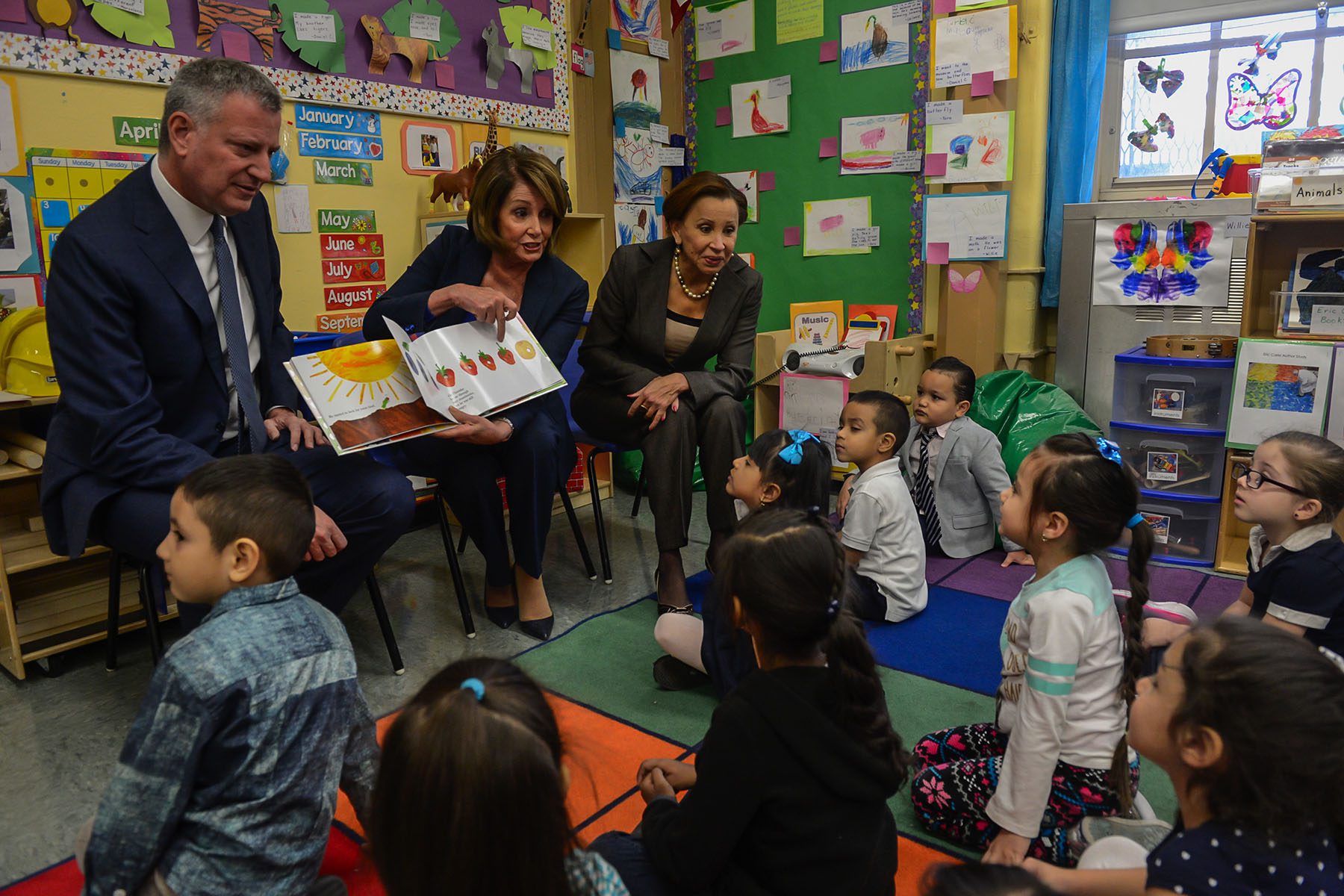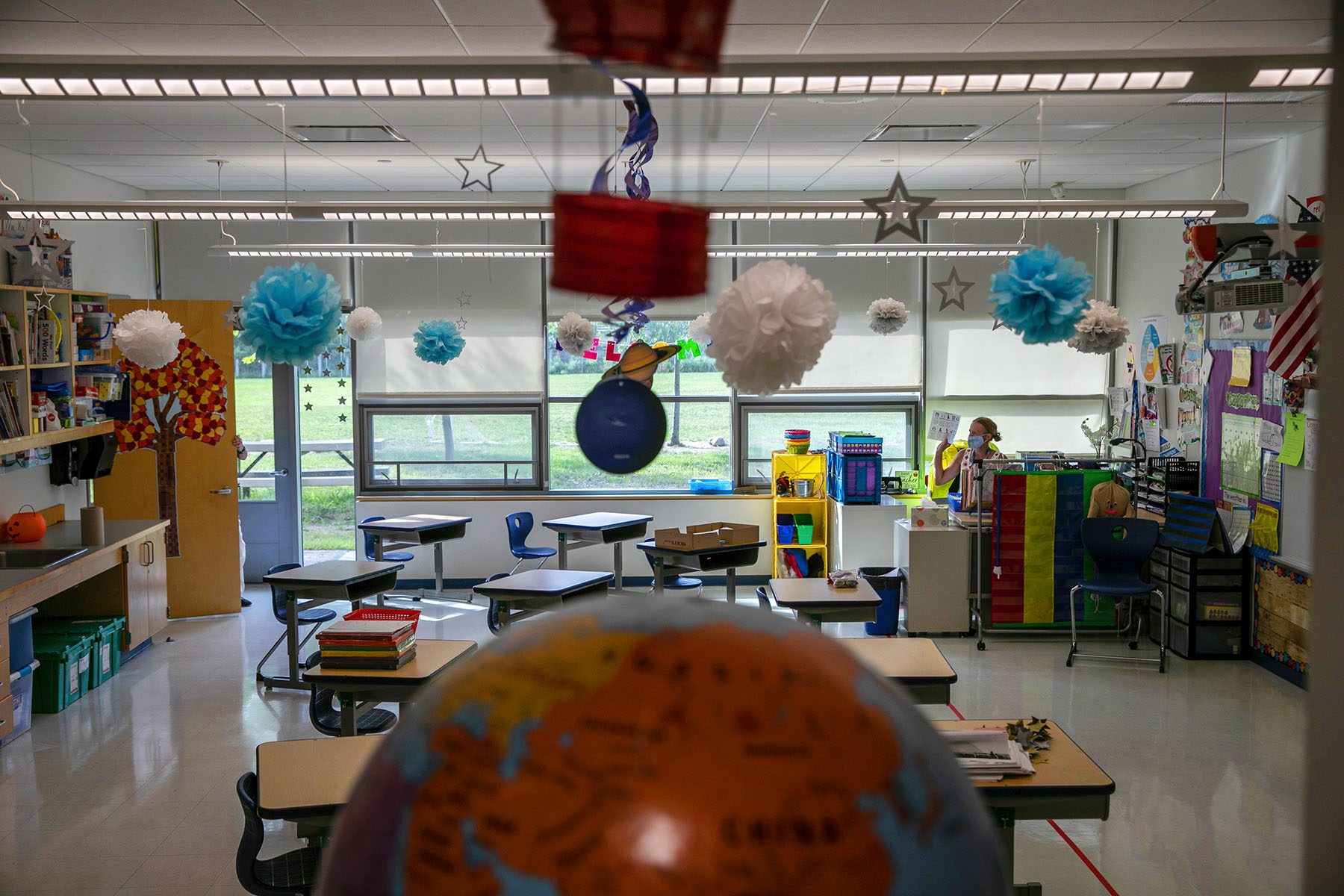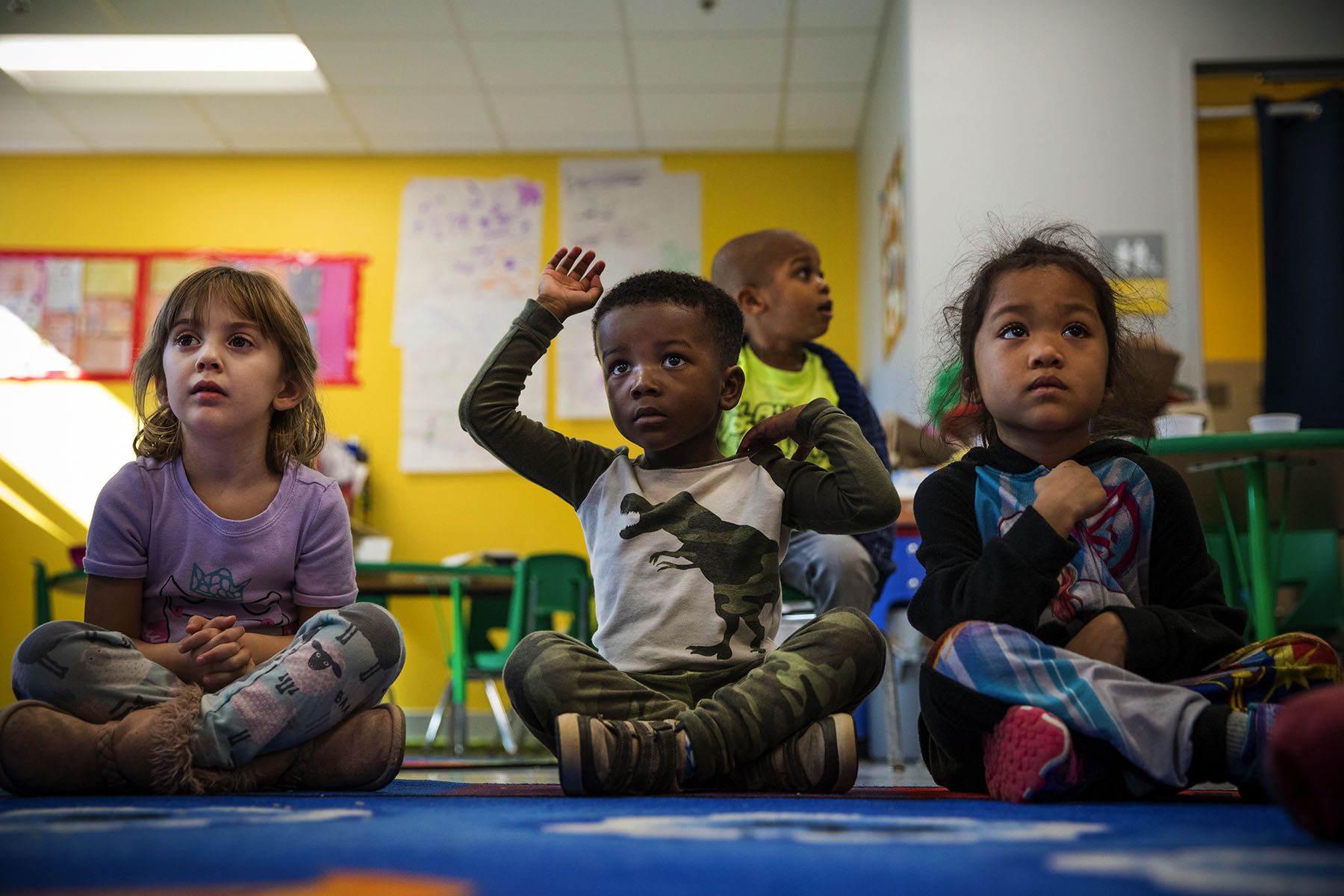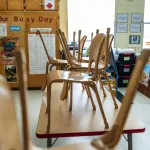In 2014, New York City started rolling out a universal pre-kindergarten program that has only expanded since, becoming one of the most embraced policies in the city in years. But even the most popular ideas can have unintended consequences, and in New York, that consequence fell on child care centers.
The financial calculus for child care centers, which often operate on profit margins of less than 1 percent, relies on 3- and 4-year-olds to help subsidize the significant cost of care for infants and toddlers. Payroll eats up 60 percent or more of child care center costs, and more teachers are required to care for babies than older kids.
The 3- and 4-year-olds, then, are essential to keeping child care centers open.
When free pre-K became available for 4-year-olds in New York in 2014, they started pulling out of child care centers and enrolling at pre-K centers or elementary schools. A study by the Center for New York City Affairs at the New School found that from 2014 to 2019, the number of 4-year-olds enrolled at subsidized child care centers that contract with the city dropped by 25 percent. Economist Jessica Brown at Princeton University found that universal pre-K in New York reduced child care centers’ capacity for children under the age of 2 by 2,700 seats, likely because some centers closed. That decline happened almost exclusively in poorer areas of the city, shutting out children and parents who had the greatest need.
This year, universal pre-K has reached national prominence. Part of the $3.5 trillion legislative package that President Joe Biden and many Democrats are trying to get through Congress would allocate $450 billion to stand up a nationwide, free pre-K program for 3- and 4-year-olds. It would also invest in child care, creating more centers, subsidizing the majority of the cost of care and raising pay for child care workers.
Together, the two pieces could radically change the early childhood education landscape, but their success depends on building a system that won’t undercut certain groups or lead to additional closures in an industry decimated by the pandemic.
“We see the child care and preschool proposals working hand in hand, and really see it as key for them to be working really closely together to build a full birth-through-5 system,” said Sarah Rubinfield, the director of government affairs at the First Five Years Fund, a child care advocacy organization. “Funding has been braided together.”
Most attempts to beef up resources for early learning, like New York’s, have funded either child care or pre-K, but not both. The administration’s proposal takes the lessons from those programs and combines them, making for a complex piece of legislation that doesn’t cover all the details of implementation. Because Democrats are trying to pass it as part of a package through a process known as reconciliation, all of the particulars in the bill have to directly affect spending.
Components such as exactly how the states would get money to centers have not yet been ironed out. In fact, much of this undertaking would fall on states that would be contending with millions of dollars more than what they typically get to reimagine their approach to early education, while connecting to centers to ensure they get the funds, setting quality standards, addressing the critical staffing shortage facing child care, and ensuring most parents pay no more than 7 percent of their earnings on child care.
The need is clear: A National Academy of Sciences study found that there is “incontrovertible” evidence that investing in early childhood education has significant positive impacts on children’s development. And yet, the United States invests fewer public dollars in early childhood education and care than almost all other developed countries — almost half as much as the European Union.
In 2019, the nation spent about $12,800 per child for children ages 5 to 18, according to a recent report from the Treasury Department. For 3- and 4-year-olds, it spent $2,800 per child. And for infants to 2-year-olds, the United States invests less than $500 per child.
Only about 20 percent of kids who are eligible for subsidized care under the largest child care assistance program for low-income families actually get those subsidies.
To create true access in a program the size of what’s being proposed, advocates say safeguards will have to be in place to avoid the consequences New York experienced.

One safeguard built into the proposed legislation would ensure that 3- and 4-year-olds can access free pre-K from any setting — not just a preschool, but also child care centers, home-based providers and other educational entities that meet health and safety standards. That means children don’t necessarily need to be pulled out of child care centers to receive free pre-K.
“The strength of the mixed-delivery system is, on the financial side, to make sure that providers have that mix of infant, toddler and preschool kids that really make the numbers work and strike that balance financially,” Rubinfield said. “But it also ensures parents have options to meet their needs.”
Those options could mean that a parent keeps their kid in a center to ensure continuity of care with staff who already know the child. Or it could mean they put the child in a public preschool because they have an older child who already attends that school. It could mean they simply choose a preschool because it has more resources than the day care option. Or they choose the child care center because it’s closer to home.
That could solve one piece of what Brown documented in New York. But there is another snag: Preschool operates during the school day and school year — not year round or potentially all day. Even if providers are being subsidized for their care for 3- and 4-year-olds, that subsidy won’t cover all the care they were providing before, potentially undercutting revenue.
“These day cares in general operate under this model where they need to have full-time, full-year enrollment to stay in business,” said Brown, who is now an economics professor at the University of South Carolina. “If you are only getting reimbursed for school day and school year attendance, that might not be enough.”
Any cuts to revenue can be disastrous. During the pandemic, the child care industry contracted by 83 percent between February and October 2020. Even a year later, 1 in 7 child care jobs have been lost since the start of the pandemic. For a center, even a month with reduced revenue will erase profit margins, the Treasury report found.
This is where the braiding of the child care and pre-K funding pieces could help, said Julie Kashen, a senior fellow and director for women’s economic justice at the Century Foundation.
Much of the funding included for child care is expected to be used on children under 3, Kashen noted. Under the proposal being considered by Congress now, those costs would be completely covered by the federal government for the first three years of the program. By year four, states would be expected to cover 10 percent. For preschool funding, states would have to contribute a 10 percent match beginning in the fourth year of the program, 2025, that would rise to 40 percent by 2028.
All of those funds can help make up the cost and give centers room to offer wraparound care before and after school, for example.
“There’s actually a lot of incentive to make sure you’re investing in the younger kids,” Kashen said. “This really would take us … to a very transformative [place for child care policy], to really go from a block grant to a guarantee.”
A significant portion of that guarantee has been earmarked for building up the availability of child care and preschool in the early years of the program. About 50 percent of Americans live in child care deserts — areas where there are more than three kids for every slot available.
The money to build more child care centers and improve the current ones would increase as the program continues: $20 billion in 2022, $30 billion in 2023 and $40 billion in 2024.
But how do you staff these centers?
Retention and staffing shortages are at a critical point in early learning, which has a workforce that is 95 percent women and a third people of color. The median hourly pay for child care workers was $12.24 in 2020. In a recent push to eliminate labor shortages, retailers like Amazon and McDonalds are offering higher wages than that for jobs that typically require less responsibility than caring for children.
Ensuring qualified teachers fill the spots created by the program could be a challenge, Brown said, and one that can be mitigated only if pay and advancement opportunities are created.
“Hopefully, theoretically, the people who have the jobs right now are the best parts of the labor pool, and if you expand, you are getting worse parts of the labor pool,” Brown said. “Part of the hope is that, by raising the wage, you are expanding the labor pool and maybe drawing high-quality people who would have gone to other sectors — but these are all difficult questions.”

A study from researchers at the University of Virginia found that increasing pay even marginally helps retain early childhood teachers. When researchers gave randomly selected teachers a $1,500 bonus to stay in their positions for eight months, turnover was cut in half. Turnover in child care can be as high as 40 percent. Recent research in Louisiana found turnover to be as high as 50 percent — and that was pre-pandemic.
“What we are hearing on the ground is the tension of not being able to be responsive in the ways other businesses are being responsive. If your teachers are leaving for jobs at Lowe’s and Target and Walmart and you don’t have the capacity to charge your family more at your site, then you are sort of stuck in this position,” said Daphna Bassok, an associate professor of education and public policy at the University of Virginia who led the research on retention rates.
Under the current proposed package, states must use the child care money to provide a living wage, at minimum, and raise wages to be equivalent with elementary school teachers with similar credentials within the first three years of the program. The specifics of the design are still being fine-tuned with a focus on equity, said Kashen at the Century Foundation.
“How do we make sure that it doesn’t become something that public equity is like, ‘There are government dollars, we want some of that.’ How do we make sure that it retains the integrity of being a woman- and people of color-led sector, rather than crowd them out?” she said.
Raising those wages so that retention improves will hinge on another big change that the legislation lays out: changing the algorithm for how we determine what child care really costs. Until now, centers had set rates based on the market. But what parents can afford to pay and centers can afford to charge is based on a model without government subsidies.
If the structure of how care is priced is changed to capture the true cost of delivering care, then the federal government can come in and subsidize enough of it so that parents don’t end up spending more than 7 percent of their income on child care — a percentage determined by the Department of Health and Human Services as affordable — and centers aren’t always on the brink of closure.
-
More from The 19th
- The 19th Explains: What parents need to know about the Pfizer vaccine’s safety in 5- to 11-year-olds
- Girls are being socialized to lose political ambition — and it starts younger than we realized
- Maggie Hassan makes a personal case for more caregiver funding in the reconciliation bill
Today, families with kids under the age of 5 spend about 13 percent of their income on child care on average. If the cost is capped at 7 percent, most parents would see their child care costs drop by about $5,000 to $6,500 a year, according to an analysis by the Center for American Progress, a left-leaning think tank.
But ultimately, the decision about what the true cost of care is, and how that’s determined, will be left up to the states. And here is where the biggest wrench could be.
Even if the package passes, states can decide to reject child care funds, just as 12 rejected Medicaid expansion under the Affordable Care Act, leaving a coverage gap where millions of Americans do not earn enough to qualify for subsidies under the ACA but earn too much to qualify for Medicaid.
“The reality is if we can get this done, we are still going to have to work with states,” said Anne Hedgepeth, the senior director of federal and state government affairs at Child Care Aware of America, a child care advocacy group. “That’s where we can really also create the guardrails needed to make sure that no particular kind of early learning setting or age group faces unintended consequences as a result of what could be a tremendous influx of long-needed resources.”
The bill currently includes a provision that would allow cities, counties and grantees under Head Start — the child care program for low-income families — to receive the subsidies in lieu of the state in the form of grants. That’s something experts say could put pressure on states to adopt the funds because of the visibility of some cities and counties getting the funds while others are shut out.
Child care and preschool funding already has significant bipartisan support, both in Congress and among voters. Polling by the First Five Years Fund in five Republican-led states and 40 Republican-held congressional districts found that 71 percent of voters — including 56 percent of Republicans — think their governors should accept the child care funding in the proposal if it passes.
The pandemic has also already created something of a roadmap. Earlier this year, states got an unprecedented $39 billion to spend on improving their child care systems — the largest boost in child care funding to date.
In the months since, states have started to work through where they would put those funds, building up better lists of where child care providers are located, what the needs are and how to reach them.
“Even though there are gaps for sure … it does tell us there is some real ability for state-led agencies to adapt and to make this happen,” Hedgepeth said.
Ultimately, if it passes Congress, a program of this scale and size will create questions about whether the design truly leads to access — nothing like it has been tried in the United States yet.
“Are there still going to be problems to solve after this investment? Does it cover everything?” Bassok said. “I think it will not. But it totally overhauls our approach to funding and it basically expands education by several years.”








